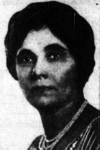 I usually try to stay on the Hill for these pieces. Occasionally, however, there is reason to go further afield. Like when the D.C. Council asks questions that seem custom-made for me. This week, I try to answer their question: “Why is there a Unicorn Lane NW?”
I usually try to stay on the Hill for these pieces. Occasionally, however, there is reason to go further afield. Like when the D.C. Council asks questions that seem custom-made for me. This week, I try to answer their question: “Why is there a Unicorn Lane NW?”
Unicorn Lane is an odd street, to be sure. It is a loop with a single cul-de-sac leading off it. The whole thing is connected by a short stub of a street to Oregon Ave NW, tucked into the topmost corner of the city.
The whole area was not developed until well into the 20th Century. The 1919 Baist atlas of D.C. shows a number of streets that were only notional at the time, and the land on which Unicorn Lane was eventually built is split into two lots, but there is only one house on one of the lots, and the driveway to that house meanders through the other lot, which seems to indicate some sort of covalence between the two.
The story here really begins with Emma T. Hahm (pic), who ran a restaurant and was a member of Zonta International –essentially a Rotary Club for women. Hahm built an estate on this land that was named the Bonnie Brae. She held many fundraisers here over the years until her death in 1949. After her death, little happened with the estate until 1963, when the Soviet Union decided that this land would be a perfect place for their embassy. After local residents protested, the Board of Zoning Adjustment went back on their original decision and denied the building permit. It would be another ten years before a developer would makes plans for the land.
In 1972, the Great Universal Development Company, announced that they had a plan for this property. They were far from the first to signal that they had a plan for it, but the previous three developers had failed. Great Universal actually managed to build, under the name Chatsworth. Designed as a gated community with only the one entrance from Oregon Avenue, it had as its symbol a unicorn, which an advertisement at the time was, “a mark of uniqueness, which characterizes the community.”

Detail of 1919 Baist map showing area on which Unicorn Lane was built. At bottom is Tennyson Street, at top is Worthington Street, At far right is Rock Creek Park and Oregon Avenue. Just to the left thereof is what became Bonnie Brae Estate and thereafter Unicorn Lane (LOC)
The name also made sense in that the street was built in the area where east-west streets were characterized by three-syllable names, north of Tennyson Street and south of Worthington. It therefore behooved Great Universal to come up with a name that began with ‘U’ and had three syllables – which meant that ‘Universal’ was one syllable too long. There are over 1000 words that fit this bill, but most of them begin with the prefix “un-” or “under-” and thus similar to “unskillful,” or, even worse, “underwear” – hardly appropriate for a street. One of the few words not following this pattern was “urinal,” which was, presumably, right out.
Unicorn, on the other hand, fit the bill, and it was thus chosen. The street has had its ups and downs, and included as its inhabitants Ron Brown, Secretary of Commerce who died in a plane crash in 1996. After his death, Unicorn Lane was honored with a visit from then-President Clinton.
Unicorn Lane was also one of the many places that Marion Barry used drugs with Rasheeda Moore. Barry had the keys to a house on this street owned by Lloyd N. Moore (no relation) and insisted that Ms. Moore join him there for another drug-fueled party.
Today, of course, if you want to hang out with Marion Barry, you have to come here on the Hill and visit his grave in Congressional Cemetery.
One is left to wonder, what would have happened had the Great Universal Development Company just gone with “Ulysses Lane.”
